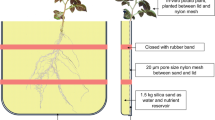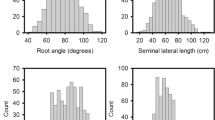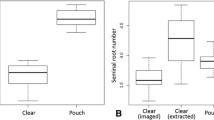Abstract
Aims
Potatoes have an inadequate rooting system for efficient acquisition of water and minerals and use disproportionate amounts of irrigation and fertilizer. This research determines whether significant variation in rooting characteristics of potato exists, which characters correlate with final yield and whether a simple screen for rooting traits could be developed.
Methods
Twenty-eight genotypes of Solanum tuberosum groups Tuberosum and Phureja were grown in the field; eight replicate blocks to final harvest, while entire root systems were excavated from four blocks. Root classes were categorised and measured. The same measurements were made on these genotypes in the glasshouse, 2 weeks post emergence.
Results
In the field, total root length varied from 40 m to 112 m per plant. Final yield was correlated negatively with basal root specific root length and weakly but positively with total root weight. Solanum tuberosum group Phureja genotypes had more numerous roots and proportionally more basal than stolon roots compared with Solanum tuberosum, group Tuberosum genotypes. There were significant correlations between glasshouse and field measurements.
Conclusions
Our data demonstrate that variability in rooting traits amongst commercially available potato genotypes exists and a robust glasshouse screen has been developed. By measuring potato roots as described in this study, it is now possible to assess rooting traits of large populations of potato genotypes.








Similar content being viewed by others
Abbreviations
- ABA:
-
Abscisic acid
- DW:
-
Dry weight
- Glm:
-
General linear model
- HI:
-
Harvest index
- L:
-
Length
- No:
-
Number
- Rt(s):
-
Root(s)
- SRL:
-
Specific root length
- SA:
-
Surface area
- Vol:
-
Volume
- Wt:
-
Weight
References
Arsenault JL, Pouleur S, Messier C, Guay R (1995) WinRHIZO, a root-measuring system with a unique overlap correction method. Hortic Sci 30:906
Balemi T, Schenk MK (2009) Genotypic difference of potato in carbon budgeting as a mechanism of phosphorus utilization efficiency. Plant Soil 322:91–99
Bradshaw JE (1994) Quantitative genetics theory for tetrasomic inheritance. In: Bradshaw JE, Mackay GR (eds) Potato genetics. CAB International, Wallingford, pp 71–99
Bradshaw JE, Bryan EJ, Ramsay G (2006) Genetic resources (including wild and cultivated Solanum species) and progress in their utilisation in potato breeding. Potato Res 49:49–65
Bradshaw JE, Dale MFB, Mackay GR (2009) Improving the yield, processing quality and disease and pest resistance of potatoes by genotypic recurrent selection. Euphytica 170:215–227
Condon AG, Richards RA, Rebetzke GJ, Farquhar GD (2004) Breeding for high water-use efficiency. J Exp Bot 55:2447–2460
Dechassa N, Schenk MK (2004) Exudation of organic anions by roots of cabbage, carrot, and potato as influenced by environmental factors and plant age. J Plant Nutr Soil Sci 167:623–629
Dechassa N, Schenk MK, Claassen N, Steingrobe B (2003) Phosphorus efficiency of cabbage (Brassica oleraceae L. var. capitata), carrot (Daucus carota L.), and potato (Solanum tuberosum L.). Plant Soil 250:215–224
Dorlodot S, Forster B, Pages L, Price A, Tuberosa R, Draye X (2007) Root system architecture: opportunities and constraints for genetic improvement of crops. Trends Plant Sci 12:474–481
Dunbabin V, Diggle A, Rengel Z (2003) Is there an optimal root architecture for nitrate capture in leaching environments? Plant Cell Environ 26:835–844
Eissenstat D (1991) On the relationship between specific root length and the rate of root proliferation:a field study using citrus rootstocks. New Phytol 118:63–68
Fabeiro C, de Santa M, Olalla F, de Juan JA (2001) Yield and size of deficit irrigated potatoes. Agric Water Manag 48:255–266
Fan MS, Zhu JM, Richards C, Brown KM, Lynch JP (2003) Physiological roles for aerenchyma in phosphorus-stressed roots. Funct Plant Biol 30:493–506
Gewin V (2010) An underground revolution. Nature 466:552–553
Gregory PJ, Simmonds LP (1992) Water relations and growth in potatoes. In: Harris PM (ed) The potato crop: the scientific basis for improvement. Chapman and Hall, London, pp 214–246
Gregory PJ, McGowan M, Biscoe PV, Hunter B (1978) Water relations of winter wheat. I. Growth of the root system. J Agric Sci 91:91–102
Hammond JP, Broadley MR, Bowen HC, Spracklen WP, Hayden RM, White PJ (2011) Gene expression changes in phosphorus deficient potato (Solanum tuberosum L.) leaves and the potential for diagnostic expression markers. PLoS One 6(9):e24606
Henry A, Kleinman PJA, Lynch JP (2009) Phosphorus runoff from a phosphorus deficient soil under common bean (Phaseolus vulgaris L.) and soybean (Glycine max L.) genotypes with contrasting root architecture. Plant Soil 317:1–16
Ho MD, McCannon BC, Lynch JP (2003) Optimization modeling of plant root architecture for water and phosphorus acquisition. J Theor Biol 226:331–340
Hoagland DR, Arnon DI (1950) The water-culture method for growing plants without soil. Calif Agric Exp Station Circ 347:1–32
Hodge A (2004) The plastic plant: root responses to hetrogeneous supplies of nutrients. New Phytol 162:9–24
Hodge A (2009) Root decisions. Plant Cell Environ 32:628–640
Hulshof CM, Swenson NG (2010) Variation in leaf functional trait values within and across individuals and species: an example from a Costa Rican dry forest. Funct Ecol 24:217–223
Iwama K (2008) Physiology of the potato: New insights into root system and repercussions for crop management. Potato Res 51:333–353
Khazaei H, Mohammady S, Zaharieva M, Monneveux P (2009) Carbon isotope discrimination and water use efficiency in Iranian diploid, tetraploid and hexaploid wheats grown under well-watered conditions. Genet Resour Crop Evol 56:105–114
Kirkegaard JA, Lilley JM, Howe GN, Graham JM (2007) Impact of subsoil water use on wheat yield. Aust J Agric Res 58:303–315
Levy D, Veilleux RE (2007) Adaptation of potato to high temperatures and salinity—a review. Am J Potato Res 84:487–506
Lobell DB, Burke MB, Tebaldi C, Mastrandrea MD, Falcon WP, Naylor RL (2008) Prioritizing climate change adaptation needs for food security in 2030. Science 319:607–610
Lynch JP (2007) Roots of the second green revolution. Aust J Bot 55:493–512
Lynch JP, Brown KM (2001) Topsoil foraging—an architectural adaptation of plants to low phosphorus availability. Plant Soil 237:225–237
Lynch JP, Ho MD (2005) Rhizoeconomics: carbon costs of phosphorus acquisition. Plant Soil 269:45–56
Meinzer FC, Grantz DA (1990) Stomatal and hydraulic conductance in growing sugarcane; stomatal adjustment to water transport capacity. Plant Cell Environ 13:383–388
Mokany K, Ash J (2008) Are traits measured on pot grown plants representative of those in natural communities? J Veg Sci 19:119–126
Niemira BA, Safir GR, Hammerschmidt R, Bird GW (1995) Production of prenuclear minitubers of potato with peat-based arbuscular mycorrhizal fungal inoculum. Agron J 87:942–946
Opena GB, Porter GA (1999) Soil management and supplemental irrigation effects on potato: II. Root growth. Agron J 91:426–431
Porter GA, Opena GB, Bradbury WB, McBurnie JC, Sisson JA (1999) Soil management and supplemental irrigation effects on potato: I. Soil properties, tuber yield, and quality. Agron J 91:416–425
Rewald B, Ephrath JE, Rachmilevitch S (2011) A root is a root is a root? Water uptake rates of Citrus root orders. Plant Cell Environ 34:33–42
Richards RA, Rebetzke GJ, Watt M, Condon AG, Spielmeyer W, Dolferus R (2010) Breeding for improved water productivity in temperate cereals: phenotyping, quantitative trait loci, markers and the selection environment. Funct Plant Biol 37:85–97
Sachs J, Remans R, Smukler S, Winowiecki L, Andelman SJ, Cassman KG, Castle D, Defries R, Denning G, Fanzo J, Jackson LE, Leemans R, Lehmann J, Milder JC, Naeem S, Nziguheba G, Palm CA, Pingali PL, Reganold JP, Richter DD, Scherr SJ, Sircely J, Sullivan C, Tomich TP, Sanchez PA (2010) Monitoring the world’s agriculture. Nature 466:558–560
Sattelmacher B, Kuene R, Malagamba P, Moreno U (1990) Evaluation of tuber bearing Solanum species belonging to different ploidy levels for its yielding potential at low soil fertility. Plant Soil 129:227–233
Schiermeier Q (2008) A long dry summer. Nature 452:270–273
Stalham MA, Allen EJ (2001) Effect of variety, irrigation regime and planting date on depth, rate, duration and density of root growth in the potato (Solanum tuberosum) crop. J Agric Sci 137:251–270
Steckel JRA, Gray D (1979) Drought tolerance in potatoes. J Agric Sci 92:375–381
Steudle E (2000) Water uptake by plant roots: an integration of views. Plant Soil 226:45–56
Tilman D, Cassman KG, Matson PA, Naylor R, Polasky S (2002) Agricultural sustainability and intensive production practices. Nature 418:671–677
Watt M, Magee LJ, McCully ME (2008) Types, structure and potential for axial water flow in the deepest roots of field-grown cereals. New Phytol 178:135–146
White PJ, Broadley MR, Hammond JP, Thompson AJ (2005a) Optimising the potato root system for phosphorus and water acquisition in low-input growing systems. Asp Appl Biol 73:111–118
White PJ, Broadley MR, Greenwood DJ, Hammond JP (2005b) Proceedings of the International Fertiliser Society 568. Genetic modifications to improve phosphorus acquisition by roots. IFS, York, UK. ISBN 0853102058
Wilkinson S, Hartung W (2009) Food production: reducing water consumption by manipulating long-distance chemical signaling in plants. J Exp Bot 60:1885–1891
Wishart J, George TS, Brown LK, Thompson JA, Ramsay G, Bradshaw JE, White PJ, Gregory PJ (2009) Variation in rooting habit of potatoes: potential for improving resource capture. International Symposium “Root Research and Applications”, RootRAP 2–4 September, BOKU-Vienna Austria http://rootrap.boku.ac.at/fileadmin/files/RRcd/session02/oral/069.pdf
Yuan B, Nishiyama S, Kang Y (2003) Effects of different irrigation regimes on the growth and yield of drip-irrigated potato. Agric Water Manag 63:153–167
Zebarth BJ, Tai G, Tarn R, de Jong H, Milburn PH (2004) Nitrogen use efficiency characteristics of commercial potato cultivars. Can J Plant Sci 84:589–598
Zhu J, Brown KM, Lynch JP (2009) Root cortical aerenchyma improves drought tolerance of maize (Zea mays L.). Plant Cell Environ 33:740–749
Zhu J, Ingram PA, Benfey PN, Elich T (2011) From lab to field. New approaches to phenotyping root system architecture. Curr Opin Plant Biol 14:310–317
Zimmermann P, Regierer B, Kossmann J, Frossard E, Amrhein N, Bucher M (2004) Differential expression of three purple acid phosphatases from potato. Plant Biol 6:519–528
Acknowledgments
We thank all who helped in the field with digging up the potato root systems including Catherine Rose, Jackie Thompson, Lionel Dupuy, Gladys Wright, Ankush Prashar and Gaynor Mackenzie. We also thank the JHI field staff for setting-up and maintenance of the field trials. The research was also funded by the Scottish Government Work Package 1.7 “Profitable and sustainable agriculture” (2005–2011) and Work Package 3.3 “The soil, water and air interface and its response to climate and land use change” (2011–2016).
Author information
Authors and Affiliations
Corresponding author
Additional information
Responsible Editor: Ellis Hoffland.
Rights and permissions
About this article
Cite this article
Wishart, J., George, T.S., Brown, L.K. et al. Measuring variation in potato roots in both field and glasshouse: the search for useful yield predictors and a simple screen for root traits. Plant Soil 368, 231–249 (2013). https://doi.org/10.1007/s11104-012-1483-1
Received:
Accepted:
Published:
Issue Date:
DOI: https://doi.org/10.1007/s11104-012-1483-1




